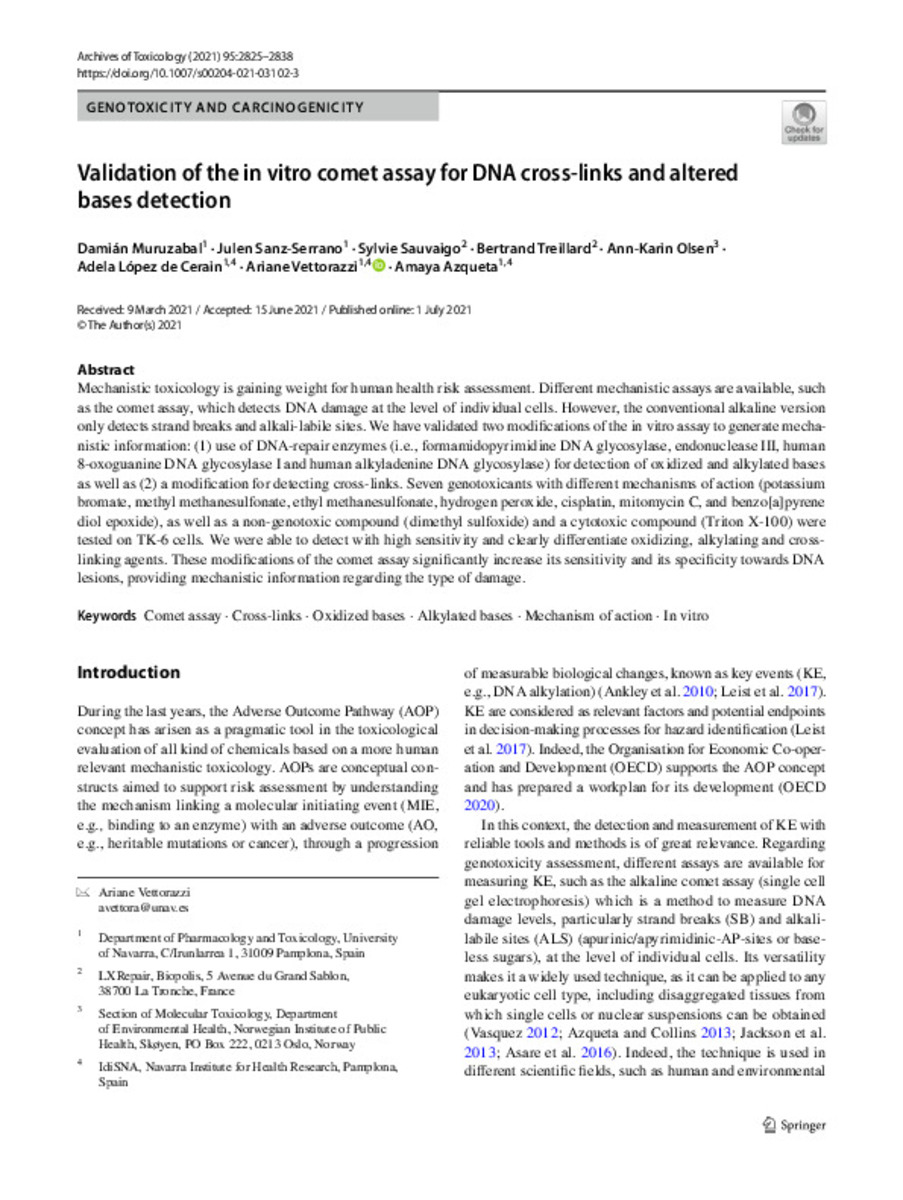Full metadata record
| DC Field | Value | Language |
|---|---|---|
| dc.creator | Muruzábal, D. (Damián) | - |
| dc.creator | Sanz-Serrano, J. (Julen) | - |
| dc.creator | Sauvaigo, S. (Sylvie) | - |
| dc.creator | Treillard, B. (Bertrand) | - |
| dc.creator | Olsen, A.K. (Ann‑Karin) | - |
| dc.creator | Lopez-de-Cerain, A. (Adela) | - |
| dc.creator | Vettorazzi, A. (Ariane) | - |
| dc.creator | Azqueta, A. (Amaya) | - |
| dc.date.accessioned | 2021-09-17T10:47:26Z | - |
| dc.date.available | 2021-09-17T10:47:26Z | - |
| dc.date.issued | 2021 | - |
| dc.identifier.citation | Muruzábal, D. (Damián); Sanz-Serrano, J. (Julen); Sauvaigo, S. (Sylvie); et al. "Validation of the in vitro comet assay for DNA cross‑links and altered bases detection". Archives of Toxicology. 95, 2021, 2825 - 2838 | es |
| dc.identifier.issn | 1432-0738 | - |
| dc.identifier.uri | https://hdl.handle.net/10171/62006 | - |
| dc.description.abstract | Mechanistic toxicology is gaining weight for human health risk assessment. Different mechanistic assays are available, such as the comet assay, which detects DNA damage at the level of individual cells. However, the conventional alkaline version only detects strand breaks and alkali-labile sites. We have validated two modifications of the in vitro assay to generate mechanistic information: (1) use of DNA-repair enzymes (i.e., formamidopyrimidine DNA glycosylase, endonuclease III, human 8-oxoguanine DNA glycosylase I and human alkyladenine DNA glycosylase) for detection of oxidized and alkylated bases as well as (2) a modification for detecting cross-links. Seven genotoxicants with different mechanisms of action (potassium bromate, methyl methanesulfonate, ethyl methanesulfonate, hydrogen peroxide, cisplatin, mitomycin C, and benzo[a]pyrene diol epoxide), as well as a non-genotoxic compound (dimethyl sulfoxide) and a cytotoxic compound (Triton X-100) were tested on TK-6 cells. We were able to detect with high sensitivity and clearly differentiate oxidizing, alkylating and crosslinking agents. These modifications of the comet assay significantly increase its sensitivity and its specificity towards DNA lesions, providing mechanistic information regarding the type of damage. | es_ES |
| dc.description.sponsorship | This work was supported by the BIOGENSA project (AGL- 70640-R) of the Ministry of Science, Innovation and Universities of the Spanish Government and the European Regional Development Fund (ERDF). | es_ES |
| dc.language.iso | eng | es_ES |
| dc.publisher | Springer | es_ES |
| dc.rights | info:eu-repo/semantics/openAccess | es_ES |
| dc.subject | Comet assay | es_ES |
| dc.subject | Cross-links | es_ES |
| dc.subject | Oxidized bases | es_ES |
| dc.subject | Alkylated bases | es_ES |
| dc.subject | Mechanism of action | es_ES |
| dc.subject | In vitro | es_ES |
| dc.title | Validation of the in vitro comet assay for DNA cross‑links and altered bases detection | es_ES |
| dc.type | info:eu-repo/semantics/article | es_ES |
| dc.description.note | This article is licensed under a Creative Commons Attribution 4.0 International License | es_ES |
| dc.identifier.doi | 10.1007/s00204-021-03102-3 | - |
| dadun.citation.endingPage | 2838 | es_ES |
| dadun.citation.publicationName | Archives of Toxicology | es_ES |
| dadun.citation.startingPage | 2825 | es_ES |
| dadun.citation.volume | 95 | es_ES |
Files in This Item:
Statistics and impact
Items in Dadun are protected by copyright, with all rights reserved, unless otherwise indicated.






